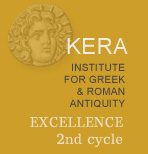Elmalı Yurt / Pırnaz
5 |
[1-2]Ḥ[-5-6-]Ο̣C̣Ο̣Υ̣[--] Η̣C̣[2-3]ΝΕ[2-3] ἐπόησεν [--]ΑΙ[3-4]Ν[--------]ρχου καλοκἀγα[θ]ίας ἕν̣ε– κεν μνήμῃ τῇ ἀ̣[γα-] θ[ῇ]. Τατε̣ίς Μ̣άγαν̣τ̣[α] τὸν ἑαυ[τ]ῆς ἄνδ̣ρ̣– α φιλοστοργ̣ί̣α[ς] ἕνεκεν. |
[- - - - - - - - - ] made this [------] for (his?) goodness in good memory. Tateis her husband Magas for his affection.
Funerary column found by Collignon in 1876 at the cemetery of Pırnaz (now Elmalı Yurt) and published in 1879. The stone is still at that cemetery.
Height: 150 cm; diameter: ca 30 cm; letters: 2-2.5 cm.
Collignon 1879, p. 41, no. 2; Schindler 1972, no. 32; Milner 1998, p. 4, no. 4.4.
L. 1-3 : If the surface of the stone was nearly as worn in 1876 as it is today, it is no surprise that Collignon had trouble reading this inscription. His text ([- - - - - - - -]/[- - - - -] ἐπόησεν / [- - - - -] [Κλεά]ρχου / καλοκἀγα[θ]ίας ἕνε/κεν μν[ήμῃ τῇ ἀγαθ]/ῇ [- - - - - - - -] / τὸν ἑαυ[τ]ῆς ἄνδρ/α φιλοσ[τοργίας?] /ἕνεκεν) is repeated in Schindler. Based on a squeeze we made in 2005, it has been possible to improve considerably the reading of the lower part (ll. 5-9). The first three lines, however, are extremely worn.
L. 4-8 : Though the expression καλοκαγαθίας ἕν̣εκεν is more common in honorary inscriptions, it is also known from a private funerary context; cf. MAMA 1 308 (Galatia). Again, μνήμῃ τῇ ἀγαθῇ is a rather unusual formulation in other areas, but one attested three times in Cibyra: IK Kibyra I 53, 57 and 60 are postum honorary inscriptions engraved on round altars. All three reflect honors bestowed to individuals by the people of Cibyra in connection with the Romans residing there. Such inscriptions begin ὁ δῆμος καὶ οἱ Ῥωμαῖοι or ὁ δῆμος καὶ οἱ πραγματευόμενοι ἐνταῦθα Ῥωμαῖοι (vel sim.) ἐτείμησαν... (cf. IK Kibyra I 47-61). Most interesting for comparison with our inscription from Boubon, is a group within this group of texts from Cibyra. IK Kibyra I 47, 57, 58 and 59 belong to a category of inscriptions that should cast doubt on the strict distinction between public and private honorary monuments:
IK Kibyra I 47: [Ὁ δῆμ]ο[ς] καὶ οἱ ἐνταῦθα / π[ρα]γματευόμενοι Ῥω/[μαῖ]οι ἐτείμησαν Ἀπολ/λώνιον Πολυδεύκου. / vac. / Τρωΐ λος καὶ Πολυδεύκης / Ἀπολλω̣νίῳ τῷ πατρὶ / μνήμης ἕνεκεν.
IK Kibyra I 57: [Ὁ δ]ῆ̣μος καὶ οἱ ἐνθάδε πρα/[γ]μ̣α̣τευόμενοι ἐτείμησ[α]ν / Μ̣ένιππον Εὐτύχου τὸν καλο[ύμε]/νον Χρυσέρωτα ἀγορανομή/σαντα τῷ νζ´ ἔτει χρυσῷ στεφά/νῳ μνήμῃ τῇ ἀγαθῇ vac. Ἀρτε/μίδωρος Χρυσέρωτι τῷ πατρὶ / vac . μνήμης / vac. ἕνεκεν.
IK Kibyra I 58: Ὁ δῆμος καὶ οἱ πρα/γματευόμενοι ἐνταῦ/θα Ῥωμαῖοι ἐτείμησαν / Ὀφέλλιον Ἀλέξανδρον. / Ἀλέξανδρος Γαΐ ῳ καὶ / Ἀλεξάνδρῳ τοῖς τέκνοις / μνήμης ἕνεκεν.
IK Kibyra I 59: Ὁ δῆμος καὶ οἱ πραγμα/τευόμενοι Ῥωμαῖοι / ἐτείμησαν Σῶσον γ´ Μύ/κου· Ἀφιας ἡ γυνὴ μνήμης / ἕνεκεν.
Since none of these stones has been found in situ, we don't know whether they stood in a cemetery or at another location. According to their inscriptions, however, the altars were tokens of both public and private recognition and gratitude. An honorific act by a public body was commemorated on a monument set up by a family member for a deceased loved one. Though there is no way to be sure failing a reliable reading of the first three lines, the funerary column from Boubon may well have carried a text belonging to this category, as the similarity of its preserved lines to the equivalent parts of the inscriptions from Cibyra, sited above, is striking.
On the female name Τατεις cf. no. 60 and no. 58 (Tata) and see Milner 1998, p. 4. It is particularly frequent in Phrygia. For Pisidia cf. MAMA 8 359; 391; Ramsay 1897, p. 308, no. 120; SEG 6 (1932), no. 593; 19 (1963), no. 815. It is also common in Cibyra; cf IK Kibyra I: 52; 145; 168; 239; 250; 254; 301; 327; 336-341; 386. On the name of the deceased placed in the accusative case (τὸν ἑαυτῆς ἄνδ̣ρ̣α), see no. 35.

